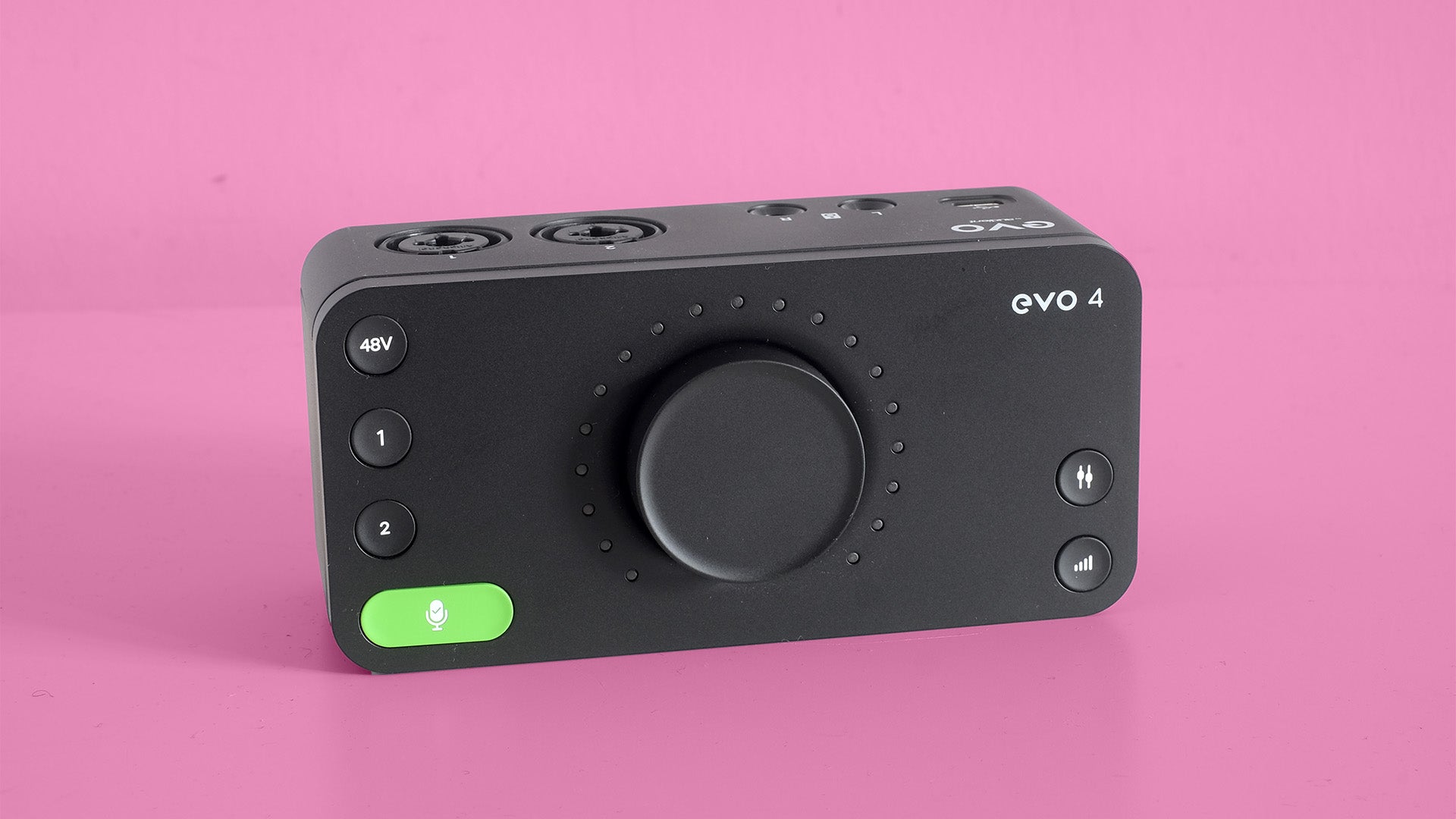Verdict
Light, approachable and surprisingly feature-rich, the Evo 4 is perfect for home studio beginners — there’s just a slight hit to a couple of audio quality elements compared to the company’s best.
Pros
- Surprisingly versatile
- Beginner-friendly
- Fairly portable
- Can be used with iPads
Cons
- Slight noise bed at high preamp volumes
- Slightly susceptible to EMF interference noise
Availability
- UKRRP: £103
- USARRP: $129
- EuropeRRP: €119
- CanadaTBC
- AustraliaTBC
Introduction
The Audient Evo 4 is one of the best audio interfaces for someone starting out in home recording, podcasting or content creation.
At first, it seems simplicity is the sole hook. The Audient Evo 4 is light on dials and knobs, is small, and has a neat feature that sets you levels automatically to avoid clipping – brilliant for beginners.
However, it’s actually a lot less restrictive than some other models you might buy at the price. This is a 2in/2out interface, better than the capable but single-input Focusrite Scarlett Solo. These inputs can be mics, line ins, and there’s a dedicated “instrument” input, for greater flexibility than is offered by the recent Focusrite Vocaster line. And it’s more portable-friendly than the Audient ID4 Mark II.
The main reason to pause is that sometimes you’ll often find the Audient ID4 selling for only slightly more online. While I have few major complaints about the Eve 4’s raw sound quality, that step-up model has more highly regarded pre-amps.
Audient sells the Evo 4 on its own for around £103 or as part of the Evo Start Recording Kit bundle. This sells for up to £195 and includes a basic but decent pair of full-size headphones, a shock mount, XLR cable and an impressively sturdy SR1 condenser mic.
Design
- 2in, 2out design
- Separate JFET instrument input socket
- USB-C connection
The Audient Evo 4 is a plastic brick. While it isn’t made purely for portable use, its footprint is smaller than that of any audio interface I’ve used in years.
It’s not actually clear which part is meant to face upwards at first glance. The top pane holds that big volume dial, so when you put the Audient Evo 4 on a desk, the headphone and guitar inputs face you.
The Audient Evo 4 is a 2in/2out interface. In this case that means you get a pair of 6.35mm sockets for studio monitors on the back, and a pair of combi XLR/6.35mm sockets for microphones or, for example, hooking up a guitar amplifier.
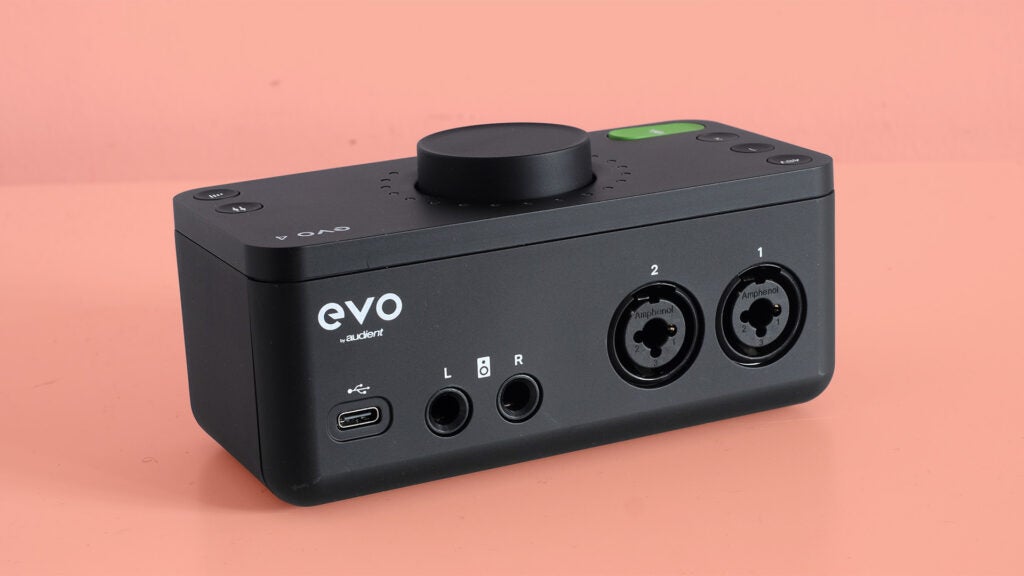
There is an instrument socket up front too, primarily for electric guitars and basses, but you’ll only need to use this if you are directly connecting — no amp. This replaces “input 1″ on the back in use. it’s not a sneaky additional third input.
However, you should definitely use it for direct guitar input. It produced a dramatically better sound than using the rear line input, presumably because of the “harmonically rich JFET instrument input circuit” Audient talks about on its website. Clarity and dynamic range seem much improved when dealing with the single coil pickups of my Stratocaster guitar.
You can also use the Audient Evo 4 with more platforms than you might guess. It works on Mac and PC without installing any extra software, and you can plug it into an iPad for use with apps like Garageband. I tried it with an older iPad Air and a USB-C to USB-C cable. No issues.
This makes the Audient Evo 4 the perfect fit for someone who might want to use their tablet as a musical sketchbook while on holiday, or even while on tour.
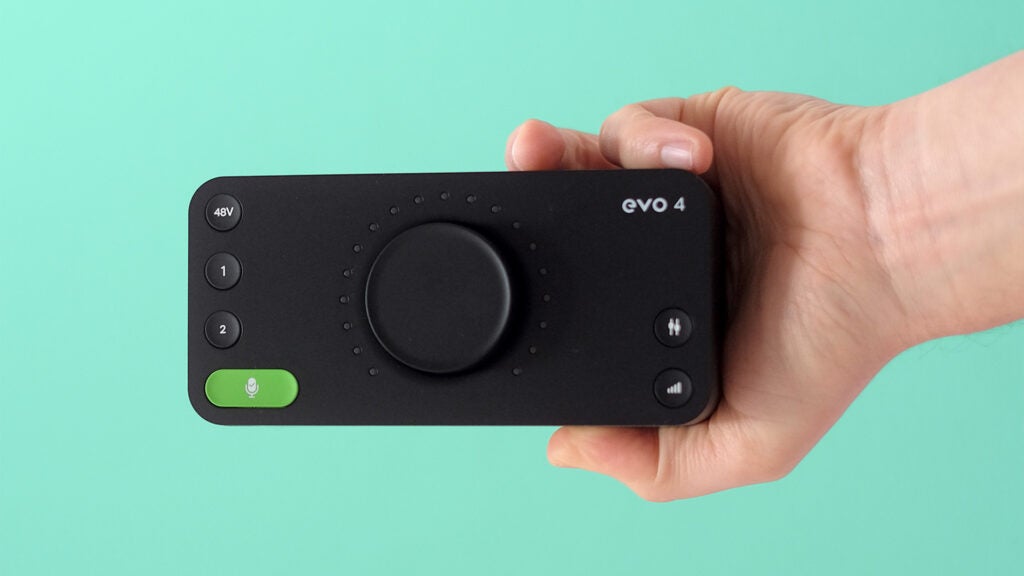
Audient’s space-saving style does mean the volume knob has to take on a whole bunch of duties, though. It’s a free-turning dial with 19 white LEDs around its perimeter. Those LEDs might tell you the global volume level, the level of inputs 1 or 2, headphone output volume or the monitor mix for one of the inputs. Or act as a VU meter for your inputs, to show you when you might be getting close to clipping.
All that stuff shown on one set of LEDs has the potential to confuse, and some may prefer the dedicated dials of the Audient ID4. However, that’s not how I felt using the Evo 4. Once you get your head around a few basics, it’s always pretty obvious what the LEDs signify, making this interface seem uncluttered rather than confusing.
Features
- Offers 48V of phantom power
- Supports PC/Mac software
- Smartgain sets input levels for microphones/instruments
This is a highly beginner-friendly interface, and Smartgain is the best example of why. It’s represented by the larger green button.
Press the green button, followed by the ‘1’ or ‘2’ button that represents the input you want to record and then press the green button again. This kicks off Smartgain. You then sing at your loudest or strum away on a guitar and the Audient Evo 4 will automatically set the channel level to avoid clipping. It’s a mini soundcheck that avoids busted takes, and takes less than 10 seconds.
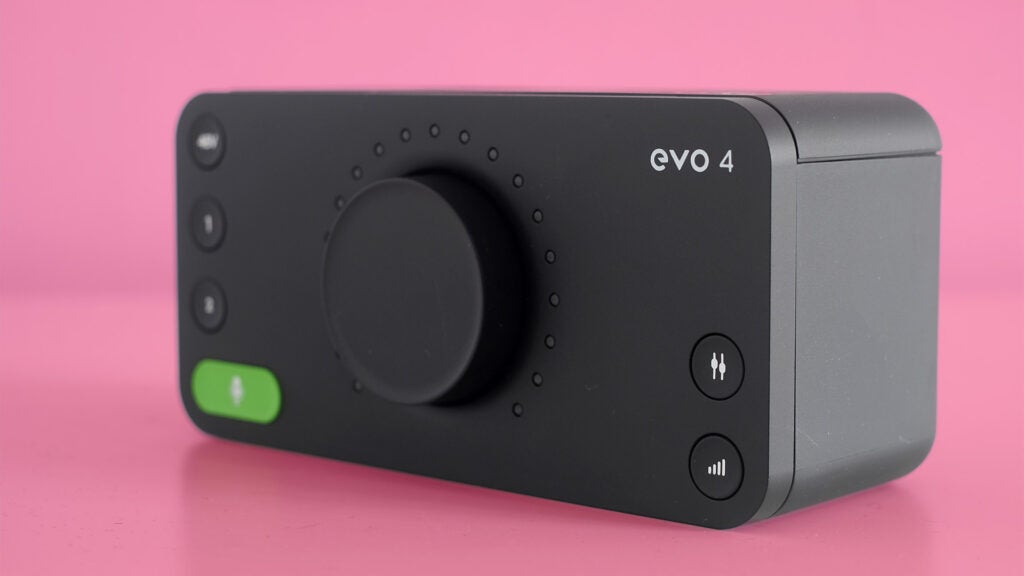
The Evo 4 offers 48V phantom power, for those who plan to use condenser mics that require it. And the little “fader” button to the right side of the control panel represents the other neat feature here. It’s a dry/wet signal control, letting you choose how much you hear of the raw signal from your guitar/mic, and how much from the output through your recording software.
Hold this down and it switches to “monitor pan”, which I only realised when reading the manual to check I hadn’t missed anything. This lets you pan the monitor feed of the two inputs left and right to as great a degree as you choose.
The Audience Evo 4 has hidden depths. However, you’ll need to download the PC/Mac Evo software to get your hands on one of the most dynamic features, Loopback.
This lets you turn outputs into an additional set of stereo inputs — handy if you want to record game audio or the feed from someone on the other end of a Skype call while recording your own mic audio on a separate track. I recommend taking a look at Audient’s own video to see more on how it works.
The more I dug into what the Audient Evo 4 can do, the wider its appeal became. At this price solid performance with two inputs is enough, but there are extras for streamers and podcasters too.
Performance
- Generally good sound quality
- Not immune to EMF interference
- Slight preamp noise bed at 75%-plus gain
Is the raw performance good enough? I think so. When you max out of the input level for the line inputs, there is a slight but noticeable noise bed. However, I can’t really think of any normal situation in which you’d want to push the pre-amps that hard. At more regular volumes the Evo 4 sounds clean, and I was particularly impressed by the quality of the instrument input — it makes the raw feed from an electric guitar sound a lot like that of a clean channel on a guitar amp.
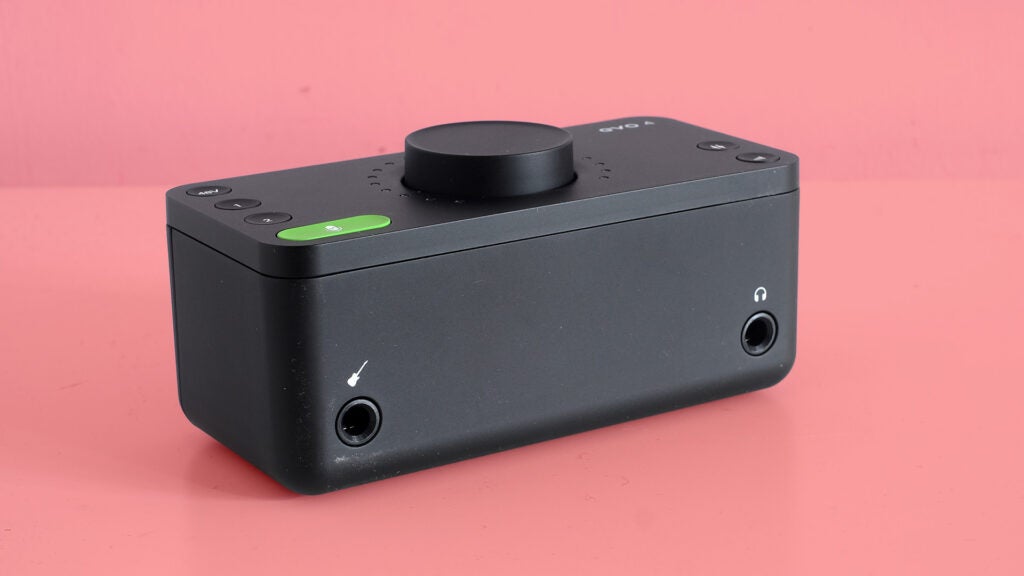
However, there is one problem — interference. When pushing the pre-amp fairly hard I could hear an odd ticking sound, which seemed to be exacerbated by connecting to a USB-C Thunderbolt hub rather than hooking up to my MacBook directly. And when listening with my phone next to the unit, switching from Wi-Fi to mobile internet introduced another form of ticking/clicking noise.
I’m not suggesting the Audient Evo 4 is unshielded — lots of folks may never notice this potential effect. The aluminium and steel casing of the Audient ID4 should help reduce this further, though. It’s the obvious pick for sound quality purists, but only has one microphone input, where the Evo has two.
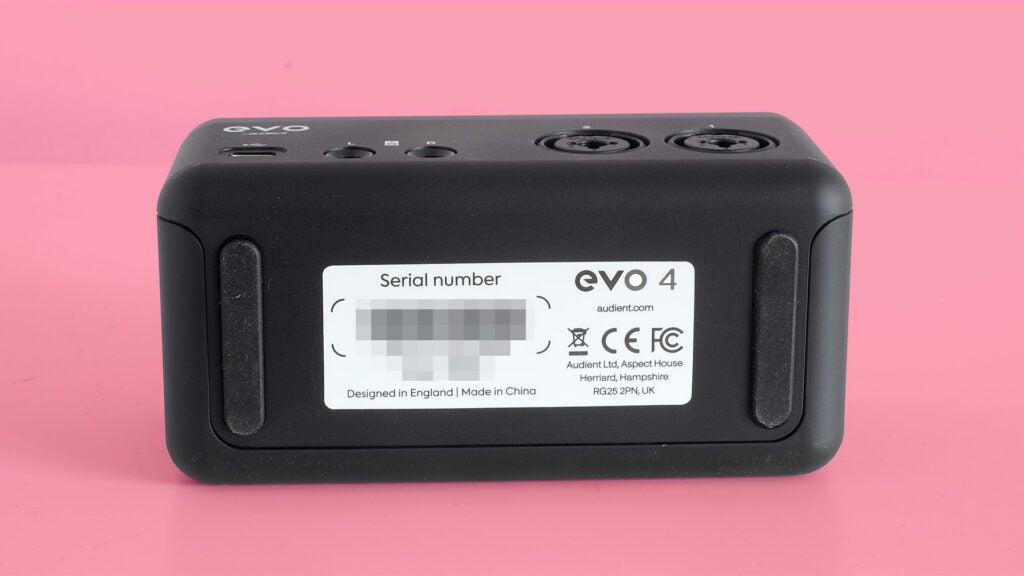
Latest deals
Should you buy it?
This is a great first serious interface for folks who want maximum versatility at a sensible price: It works across plenty of platforms and, unlike some at this level, two separate input channels.
The older Audient ID4 series is probably still a better bet for the purist: It has the same preamps used in the company’s high-end consoles and the metal shell is more resilient.
Final Thoughts
The Audient Evo 4 is a simple-looking interface that is easy to use but has greater features and flexibility than you might guess.
With two inputs and outputs, and five ways to connect recording gear including a quality instrument socket, most folks shouldn’t find themselves limited by the potential here too soon. The auto input level feature is perfect for beginners, and the software extras nod to streamers and podcasters.
The plastic build isn’t remotely as impressive as the much tougher Audient ID4’s, though, and likely doesn’t help the slight susceptibility to audible electromagnetic interference, which can become audible at high preamp volumes.
How we test
We test every amplifier we review thoroughly over an extended period of time. We use industry standard tests to compare features properly. We’ll always tell you what we find. We never, ever, accept money to review a product.
Find out more about how we test in our ethics policy.
FAQs
This interface can power headphones but its speaker outputs are made for powered speakers.
Yes, the two input channels can be muted independently.
It offers 58dB gain for its two inputs.
Sustainability
Trusted Reviews’ holds the fact that global warming is not a myth as a core value and will continuously endeavour to help protect our planet from harm in its business practices.
As part of this mission, whenever we review a product we send the company a series of questions to help us gauge and make transparent the impact the device has on the environment.
We currently haven’t received answers to the questions on this product, but will update this page the moment we do. You can see a detailed breakdown of the questions we ask and why in our sustainability info page.
Verdict
Light, approachable and surprisingly feature-rich, the Evo 4 is perfect for home studio beginners — there’s just a slight hit to a couple of audio quality elements compared to the company’s best.
Pros
- Surprisingly versatile
- Beginner-friendly
- Fairly portable
- Can be used with iPads
Cons
- Slight noise bed at high preamp volumes
- Slightly susceptible to EMF interference noise
Availability
- UKRRP: £103
- USARRP: $129
- EuropeRRP: €119
- CanadaTBC
- AustraliaTBC
Introduction
The Audient Evo 4 is one of the best audio interfaces for someone starting out in home recording, podcasting or content creation.
At first, it seems simplicity is the sole hook. The Audient Evo 4 is light on dials and knobs, is small, and has a neat feature that sets you levels automatically to avoid clipping – brilliant for beginners.
However, it’s actually a lot less restrictive than some other models you might buy at the price. This is a 2in/2out interface, better than the capable but single-input Focusrite Scarlett Solo. These inputs can be mics, line ins, and there’s a dedicated “instrument” input, for greater flexibility than is offered by the recent Focusrite Vocaster line. And it’s more portable-friendly than the Audient ID4 Mark II.
The main reason to pause is that sometimes you’ll often find the Audient ID4 selling for only slightly more online. While I have few major complaints about the Eve 4’s raw sound quality, that step-up model has more highly regarded pre-amps.
Audient sells the Evo 4 on its own for around £103 or as part of the Evo Start Recording Kit bundle. This sells for up to £195 and includes a basic but decent pair of full-size headphones, a shock mount, XLR cable and an impressively sturdy SR1 condenser mic.
Design
- 2in, 2out design
- Separate JFET instrument input socket
- USB-C connection
The Audient Evo 4 is a plastic brick. While it isn’t made purely for portable use, its footprint is smaller than that of any audio interface I’ve used in years.
It’s not actually clear which part is meant to face upwards at first glance. The top pane holds that big volume dial, so when you put the Audient Evo 4 on a desk, the headphone and guitar inputs face you.
The Audient Evo 4 is a 2in/2out interface. In this case that means you get a pair of 6.35mm sockets for studio monitors on the back, and a pair of combi XLR/6.35mm sockets for microphones or, for example, hooking up a guitar amplifier.

There is an instrument socket up front too, primarily for electric guitars and basses, but you’ll only need to use this if you are directly connecting — no amp. This replaces “input 1″ on the back in use. it’s not a sneaky additional third input.
However, you should definitely use it for direct guitar input. It produced a dramatically better sound than using the rear line input, presumably because of the “harmonically rich JFET instrument input circuit” Audient talks about on its website. Clarity and dynamic range seem much improved when dealing with the single coil pickups of my Stratocaster guitar.
You can also use the Audient Evo 4 with more platforms than you might guess. It works on Mac and PC without installing any extra software, and you can plug it into an iPad for use with apps like Garageband. I tried it with an older iPad Air and a USB-C to USB-C cable. No issues.
This makes the Audient Evo 4 the perfect fit for someone who might want to use their tablet as a musical sketchbook while on holiday, or even while on tour.

Audient’s space-saving style does mean the volume knob has to take on a whole bunch of duties, though. It’s a free-turning dial with 19 white LEDs around its perimeter. Those LEDs might tell you the global volume level, the level of inputs 1 or 2, headphone output volume or the monitor mix for one of the inputs. Or act as a VU meter for your inputs, to show you when you might be getting close to clipping.
All that stuff shown on one set of LEDs has the potential to confuse, and some may prefer the dedicated dials of the Audient ID4. However, that’s not how I felt using the Evo 4. Once you get your head around a few basics, it’s always pretty obvious what the LEDs signify, making this interface seem uncluttered rather than confusing.
Features
- Offers 48V of phantom power
- Supports PC/Mac software
- Smartgain sets input levels for microphones/instruments
This is a highly beginner-friendly interface, and Smartgain is the best example of why. It’s represented by the larger green button.
Press the green button, followed by the ‘1’ or ‘2’ button that represents the input you want to record and then press the green button again. This kicks off Smartgain. You then sing at your loudest or strum away on a guitar and the Audient Evo 4 will automatically set the channel level to avoid clipping. It’s a mini soundcheck that avoids busted takes, and takes less than 10 seconds.

The Evo 4 offers 48V phantom power, for those who plan to use condenser mics that require it. And the little “fader” button to the right side of the control panel represents the other neat feature here. It’s a dry/wet signal control, letting you choose how much you hear of the raw signal from your guitar/mic, and how much from the output through your recording software.
Hold this down and it switches to “monitor pan”, which I only realised when reading the manual to check I hadn’t missed anything. This lets you pan the monitor feed of the two inputs left and right to as great a degree as you choose.
The Audience Evo 4 has hidden depths. However, you’ll need to download the PC/Mac Evo software to get your hands on one of the most dynamic features, Loopback.
This lets you turn outputs into an additional set of stereo inputs — handy if you want to record game audio or the feed from someone on the other end of a Skype call while recording your own mic audio on a separate track. I recommend taking a look at Audient’s own video to see more on how it works.
The more I dug into what the Audient Evo 4 can do, the wider its appeal became. At this price solid performance with two inputs is enough, but there are extras for streamers and podcasters too.
Performance
- Generally good sound quality
- Not immune to EMF interference
- Slight preamp noise bed at 75%-plus gain
Is the raw performance good enough? I think so. When you max out of the input level for the line inputs, there is a slight but noticeable noise bed. However, I can’t really think of any normal situation in which you’d want to push the pre-amps that hard. At more regular volumes the Evo 4 sounds clean, and I was particularly impressed by the quality of the instrument input — it makes the raw feed from an electric guitar sound a lot like that of a clean channel on a guitar amp.

However, there is one problem — interference. When pushing the pre-amp fairly hard I could hear an odd ticking sound, which seemed to be exacerbated by connecting to a USB-C Thunderbolt hub rather than hooking up to my MacBook directly. And when listening with my phone next to the unit, switching from Wi-Fi to mobile internet introduced another form of ticking/clicking noise.
I’m not suggesting the Audient Evo 4 is unshielded — lots of folks may never notice this potential effect. The aluminium and steel casing of the Audient ID4 should help reduce this further, though. It’s the obvious pick for sound quality purists, but only has one microphone input, where the Evo has two.

Latest deals
Should you buy it?
This is a great first serious interface for folks who want maximum versatility at a sensible price: It works across plenty of platforms and, unlike some at this level, two separate input channels.
The older Audient ID4 series is probably still a better bet for the purist: It has the same preamps used in the company’s high-end consoles and the metal shell is more resilient.
Final Thoughts
The Audient Evo 4 is a simple-looking interface that is easy to use but has greater features and flexibility than you might guess.
With two inputs and outputs, and five ways to connect recording gear including a quality instrument socket, most folks shouldn’t find themselves limited by the potential here too soon. The auto input level feature is perfect for beginners, and the software extras nod to streamers and podcasters.
The plastic build isn’t remotely as impressive as the much tougher Audient ID4’s, though, and likely doesn’t help the slight susceptibility to audible electromagnetic interference, which can become audible at high preamp volumes.
How we test
We test every amplifier we review thoroughly over an extended period of time. We use industry standard tests to compare features properly. We’ll always tell you what we find. We never, ever, accept money to review a product.
Find out more about how we test in our ethics policy.
FAQs
This interface can power headphones but its speaker outputs are made for powered speakers.
Yes, the two input channels can be muted independently.
It offers 58dB gain for its two inputs.
Sustainability
Trusted Reviews’ holds the fact that global warming is not a myth as a core value and will continuously endeavour to help protect our planet from harm in its business practices.
As part of this mission, whenever we review a product we send the company a series of questions to help us gauge and make transparent the impact the device has on the environment.
We currently haven’t received answers to the questions on this product, but will update this page the moment we do. You can see a detailed breakdown of the questions we ask and why in our sustainability info page.



















